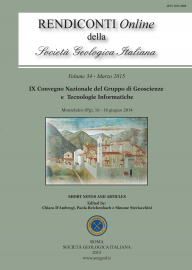
Methods and Technologies for the Cultural Heritages in Basilicata region: a case-study from the coastal belt of Metapontum
Massimo Bavusi (a), Marcello Bianca (a), Francesco Izzi (a), Paola Di Leo (a), Serena Parisi (a), Iolanda Pulice (a) & Marcello Schiattarella (b)
(a) CNR-IMAA - C.da S.Loya, 85050 Tito (PZ). E-mail: massimo.bavusi@imaa.cnr.it
(b) Department of Sciences of University of Basilicata - Via dell'Ateneo Lucano, 85050 Potenza.
Volume: 34/2015
Pages: 101-106
Abstract
The protection and promotion of Cultural Heritage require the application of innovative and non-invasive monitoring techniques for developing complete and detailed projects. The demand of cost-effective and rapid tools promoting long-term strategies for cultural heritage promotion and risk assessment is, therefore, urgent. These issues become indeed of paramount importance in the case of very large areas, such as the coastal ones, where the landscape morphoevolution - driven by climate changes - and the landscape modification - due to agricultural and industrial activities - have dramatically increased the exposure risk of Cultural Heritage. In such a framework, traditional monitoring methodologies appear impracticable. This is the reason why the MeTIBas (Italian acronym for Innovative Methods and Technologies for the Cultural Heritage in the Basilicata region) project has been developed. MeTIBas aims to develop an innovative geoarchaeological investigation approach for large areas (implementation of a Territorial Information System, drawing-up of an experimental digital geoarchaeological map, and creation of an open geoarchaeological database). MeTIBas has been developed in the coastal area of Metaponto, which roughly coincides with the ancient territory of the Greek settlement of Metapontum and its chora and includes a region of about 400 km2 in the Ionian sector of the Basilicata region (southern Italy). The data integration and joint analysis of the huge amount of MeTIBas heterogeneous data have been conveniently carried out in a GIS environment, thus allowing an effective combination of the information from different cognitive levels. Besides, the adoption of a Web GIS environment (a Geoplatform operating in Open Source Framework for Rich Web GIS Applications performed by geoSDI; www.geosdi.org) allows a wide dissemination of the information structured in the MeTIBas project.
Keywords
Get Full Text